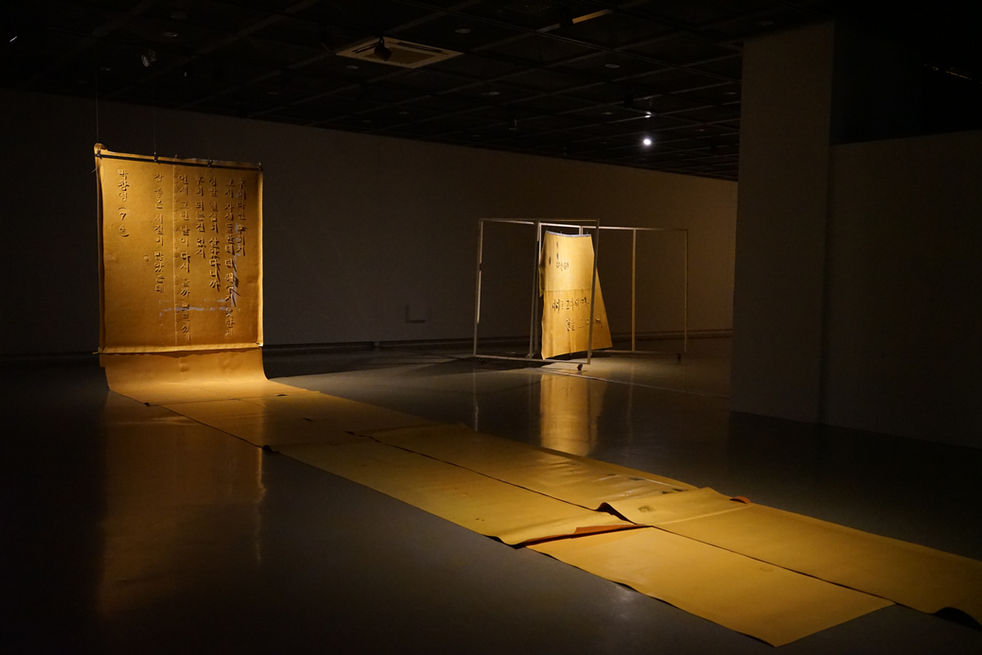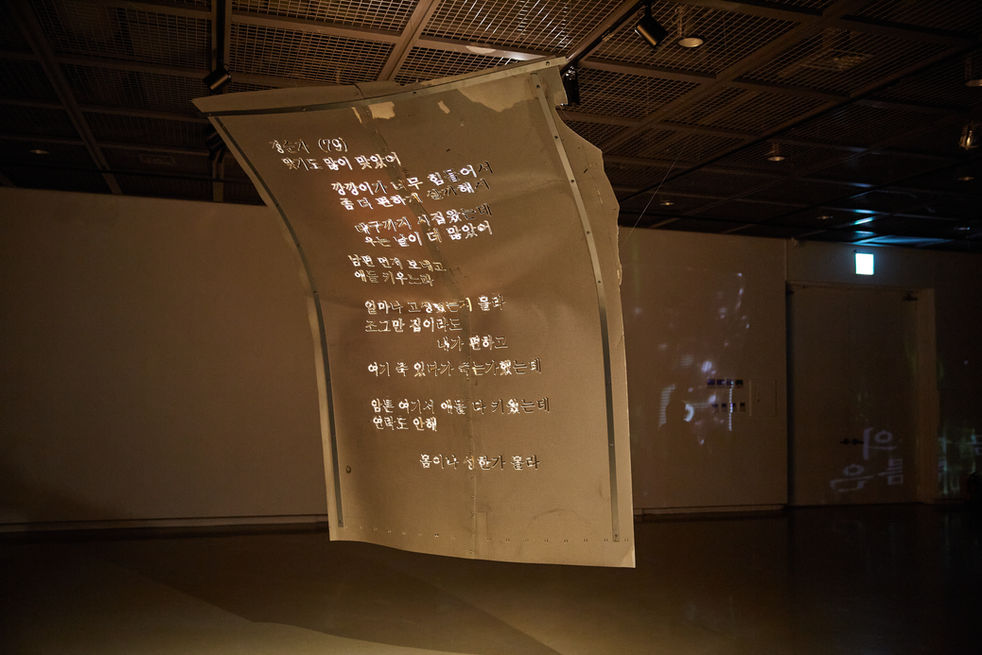
Critic
Compassion for All Living Beings
Choi Won-gyu “Engraving of Oblivion”
These ‘Jangpan’-Korean traditional linoleum flooring- you are looking at was collected by Choi Won-gyu from various locations around the city after his residency at the Daegu Art Factory in 2021. Choi Won-gyu is the kind of person who, when he sees elderly people while walking, approaches them and starts a conversation. Whether it is someone spending the whole day in a park gathering slivers of sunlight, an elderly person sitting on the bare ground in an alleyway with no chair or bench, or a vendor selling bean sprouts and vegetables on the street—Choi Won-gyu sits beside them, helps sell the bean sprouts, and talks to them as if they were old acquaintances.
During his first residency in 2020, in a large-scale public housing complex in Busan, Choi followed a worker handling old flooring materials discarded during moves or demolitions. While helping out in the homes of elderly residents, he began listening to their stories and eventually conceived the idea of using linoleum flooring in his work. He keeps these conversations in his heart until, like a living organism, they take shape over time, at which point he transcribes them in his own words. In this sense, the words written on the linoleum flooring you see are both those of the elderly individuals and Choi Won-gyu’s own.
Choi directs his attention to those whom no one notices, speaks to those to whom no one speaks. But as I, the writer, must put this into words, I asked Choi, “Why do you create this kind of work?” There could be many reasons, but fundamentally, he says, it is because he cannot stop thinking about these people. “Why do they stay on your mind?” I asked. “I don’t know,” he said. “If I had to answer, I suppose it’s because I’ve never been able to simply pass by people like that.” “Why can’t you just pass by?” I pressed further. “Well,” he replied, “I don’t see them as ‘others’ but as people no different from me. Perhaps this way of thinking comes from remembering my grandmother and father, who passed away without much recognition.” “Is this feeling related to your experiences in Ilsan, which you described as one of the hardest times in your life?” I asked. He paused. “Before Ilsan, I just ‘thought’ about these things. But after Ilsan, I started to ‘act’ on them, even in small ways—like feeding stray cats.”
Now, I ask myself: Why does Choi Won-gyu create this work? Or rather, was my question even the right one? As viewers, how should we approach this exhibition?
Michel Foucault once compiled administrative records of individuals imprisoned under the lettre de cachet system in 18th-century France—a system in which citizens could be arbitrarily detained by local authorities without trial at the request of their families. Most of these records, consisting of only three or four lines, documented those who were incarcerated and never returned. Foucault referred to this as a severe “chronicle of existence” populated by les misérables, individuals subjected to undeniable misery.
Of course, I do not wish to objectify these elderly individuals by labeling their lives as “miserable” or “harsh.” Such categorization is a form of “definitional violence,” an imposition of meaning for the convenience of the observer. The records of those imprisoned under the lettre de cachet were written in what Foucault called the “language of bureaucracy,” or, in Annie Ernaux’s words, the “language of violence.” Those in power define; those without power are defined. Those with power speak and dictate; those without power are perpetually spoken about and defined by others. These people are not simply silenced; they are those who never had a voice to begin with. (Recognizing the world’s suffering requires acknowledging the structural contradictions of a society that operates upon that very suffering—and acting accordingly.)
Choi Won-gyu collects ‘Jangpan’, converses with elderly individuals, and sometimes even replaces their old flooring with new materials—sometimes at his own expense, beyond the budgeted amount. The crucial point is that Choi engages in genuine conversation. He does not dominate the discussion, nor does he simply listen passively—he just listens a little more. He does not treat these individuals as mere “subjects” that provide material for his work. Choi is acutely aware of the risk of doing so and remains cautious.
The words inscribed on these ‘Jangpan’ tell deeply sorrowful and heartbreaking stories. One elderly woman, who moved from Busan to Daegu after marriage, spoke of being frequently beaten and shedding many tears. Another, suffering from cancer, resorted to using medicated patches as a substitute for treatment until they ultimately passed away alone. The numbers “21/19” written on one piece of flooring mark them as “the 19th unidentified deceased person of 2021.” Without Choi’s work, their lives might have left no trace on this earth.
Through his work ‘Oblivion-Imprinted’ and ‘Oblivion-Reflected’ series, Choi Won-gyu reveals the ethical, political, and social dimensions of our society with such precision that it is difficult to remain emotionally unmoved. Yet, his work never veers into self-righteousness or moralistic didacticism—it gracefully sidesteps such pitfalls.
Some believe that life and art are separate. But this is a mere illusion, a strategic misconception used to maintain dominant power structures. Life and art have never been, and can never be, separate. As Immanuel Kant pointed out, aesthetic beauty and ethical beauty often intertwine.
When Choi Won-gyu lays out these ‘Jangpan’ before us, what we come to realize is this: that life, and thus art, is always ethical, social, and political—while also being profoundly aesthetic.
Heo Kyung (Philosopher, Writer)
세상의 모든 살아있는 것들을 향한 연민
- 최원규의 ‘망각의 각인’
당신이 보고 있는 이 장판들은 최원규가 대구예술발전소 레지던시에 있던 2021년 이후 시내 곳곳에서 모은 것들이다. 최원규는 길을 걷다 어르신들을 보면 다가가 말을 거는 그런 사람이다. 공원에서 종일 햇볕 한 조각을 모으는 분이든, 골목길에서 의자도 평상도 없이 땅바닥에 앉아 이야기하는 분이든, 거리에서 콩나물과 푸성귀를 파는 분이든. 최원규는 스스럼없이 다가가 곁에 앉아 콩나물을 팔아드리고 마치 원래 잘 아는 사이라도 되듯 말을 건다. 최원규는 2020년 첫 레지던시였던 부산의 대규모 임대아파트 단지에서 이사 혹은 철거 과정에서 나오는 옛 장판을 처리하는 분을 따라 들어간 어르신들의 집에서 일을 돕고 이야기를 듣다가, 장판으로 ‘작업’을 할 수 있겠다는 생각을 하게 되었다. 최원규는 어르신들과 나눈 이야기를 자기 마음속에 간직해두고, 그 이야기가 시간이 흘러 하나의 생명처럼 스스로를 형성하는 시점이 오면, 그 이야기를 자신의 말로 다시 받아적는다. 그러니까 당신이 보고 있는 장판에 적힌 말은 어르신의 것이자 또한 최원규의 것이다.
최원규는 아무도 눈길을 주지 않는 이들에게 눈길을 주고, 아무도 말을 걸지 않는 이들에게 말을 건다. 그런데, 글을 써야 하는 나는 최원규에게 물었다. 왜 이런 작업을 하는가? 여러 가지 이유를 댈 수도 있겠지만, 근본적으로는 그분들이 눈에 밟혀서이다. 왜 눈에 밟히는가? 모르겠다. 만약 꼭 대답을 해야 한다면, 나는 원래 그런 분들을 그냥 지나치지 못하는 사람인 것 같다. 왜 그냥 지나치지 못하는가? 글쎄, 그분들이 그냥 남들이라기보다는 나와 다르지 않은 사람이라는 생각이 들어서인데, 이런 생각은 아마도 알아주는 이 없이 돌아가신 나의 할머니와 아버지를 떠올렸던 것 같기도 하다. 이런 마음은 가장 힘든 시기였다는 일산에서의 경험과도 비슷한 맥락에 있는 것인가? 이전까지는 그냥 ‘생각’을 했지만, 일산 이후로 (작은 일이지만, 길고양이에게 밥을 주는 것 같은) ‘행동’을 시작하게 된 것 같다. 이제, 나는 나 자신에게 묻는다. 최원규는 왜 이런 작업을 할까? 아니, 질문은 ‘제대로’ 제기되었던 것일까? 작가 최원규가 아니라, 관객인 당신과 나는 이 전시를 어떻게 보아야 할까?
미셸 푸코는 프랑스 18세기에 ‘가족의 요청에 따라, 특별한 재판절차 없이, 지방 행정관의 (자의적) 결정만으로 시민을 구금할 수 있었던’ <봉인장>(lettre de cachet) 제도에 의해 감금된 (그리고 대부분 돌아오지 못한) ‘구금자’에 대한 (대부분 겨우 3~4줄에 불과한) 행정 기록들을 묶어냈다. 푸코는 이를 이견의 여지 없이 비참한 이들(les misérables)이 등장하는 엄혹한 ‘실존의 연대기’라고 불렀다. 물론 나는 이분들의 삶을 ‘비참하다, 엄혹하다’는 등의 말로 대상화하고 싶지 않다. 이러한 대상화는 그저 자기 편한 대로, 편의에 따라, 재단하는 ‘규정 폭력’에 다름 아니다. <봉인장>에 의해 감금된 이들에 대한 행정 기록은 ‘관공서의 언어’ 곧 - 아니 에르노의 표현대로 - 폭력의 언어로 기술되어 있다. 권력자란 규정하는 자이다. 권력이 없는 자란 ‘규정당하는 자’이다. 권력자란 말하고 규정하는 자이다. 권력이 없는 자란 늘 (남들의 말에 의해) ‘규정되는 자’이다. 이들은 말을 잃은 자가 아니라, ‘한 번도 갖지 못한 자’에 더 가깝다(세계의 비참에 대한 ‘인식’은 이런 비참에 기반해서만 작동하는 사회의 구조적 모순에 대한 인식과 행동을 ‘요청’한다).
최원규는 이렇게 장판을 받아오고, 때로는 어르신들과 말씀을 나누고 장판을 새것으로 갈아드린다(때로는 산정된 액수를 초과해 사비로 장판을 갈아드리기도 했다). 중요한 것은 최원규가 이야기를 나눈다는 사실이다. 최원규는 대화를 독점하지도, 이분들의 이야기를 일방적으로 듣지도 않는다(다만 ‘조금 더’ 들을 뿐이다). 최원규는 이들을 작업의 소재를 제공하는 ‘대상’으로 여기지 않는다. 최원규는 자신이 그럴 위험성을 늘 인식하고 조심하고 있다고 말한다. 최원규가 장판 위에 다시 적어놓은 이 이야기들은 사실 몹시도 슬프고 가슴 아픈 말들이다. 부산에서 대구로 시집와 맞기도 울기도 많이 했다는 어르신, 암을 앓고 있었는데도 아픈 부위에 파스를 붙이는 것으로 ‘치료’를 하다 고독사한 어르신(장편에 새겨진 21/19라는 숫자는 ‘2021년 무연고자 중 19번째’라는 표식이다)의 삶은 최원규의 작업이 아니었다면 지상에 한 줄의 흔적조차 남지 않았을지도 모른다. ‘장판’과 이전의 ‘거울’ 시리즈를 통틀어, 최원규의 작업은 ‘때로 그 앞에서 평정심을 지키기가 쉽지 않을 만큼’ 우리 사회의 윤리적 정치적 사회적 주제를 섬세히 잘 드러내면서도, 결코 독선적이거나 생경한 도덕주의에 빠지지 않는다. 오히려 이를 넉넉히 피해 나간다. 사람들은 때로 삶과 예술이 둘인 줄 안다. 그러나 이는 다만 관념의 착각이자, 지배의 전략일 뿐, 삶과 예술은 결코 둘인 적도, 둘일 수도 없다. 칸트가 갈파한 것처럼, 때로 심미적 아름다움과 윤리적 아름다움은 서로를 넘나든다. 최원규가 우리 앞에 이 ‘장판들’을 펼쳐 보일 때, 우리가 깨닫게 되는 것은 삶이, 그리고 예술이, 오직 윤리적이고 사회적이며 정치적인 동시에 심미적인 것이라는 사실이다.
허경 (철학자, 작가)



















